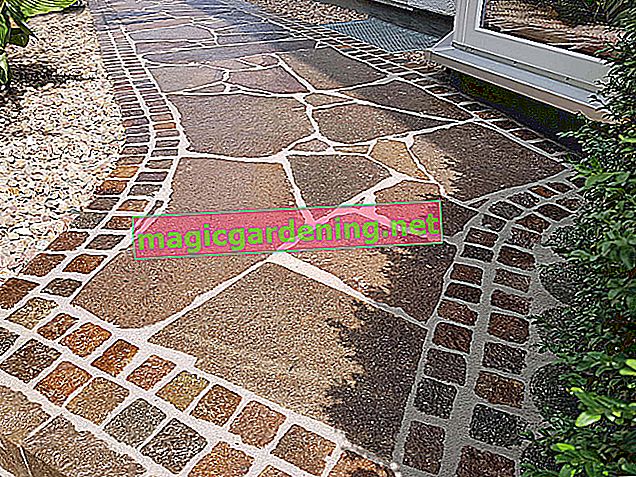
How to pave your garden path
There are also numerous design options available to you when paving your garden path. You can choose to use inexpensive paving stones or expensive natural stones. In any case, start your work by planning and purchasing the materials you need. Before the actual paving work, mark out the planned path and dig it out about 30 cm.
also read
- Garden paths made of gravel - tips and tricks for design
- Paving the garden yourself - how to lay paving stones correctly
- How much does it cost to pave a garden path?
Would you like to add curbs to your path or do without them? Since these stones are laid first and significantly widen the required excavation, you should decide when planning the edge of the path. If you have decided on curbs, then pour the concrete foundation. Put the selected curb stones in the still damp concrete and let everything dry thoroughly.
Then create the substructure, which consists of a frost protection layer and a leveling layer. Both should be compacted well. Lay the selected paving stones overhead, so to speak, that is, you work from the area that has already been laid. The distance between the individual stones should be even and about 3 to 5 mm wide.
The completion of your paving work
Fill the joints with fine and dry sand. Quartz sand (€ 14.90 at Amazon *) is very suitable for this. It's best to do this job on a dry day, otherwise the sand will get damp and won't work well into the joints.
Sweep the sand diagonally across the paved area until all the joints are filled. With a surface vibrator you ensure a nicely level and well paved path. Some joints may have to be filled with sand again after shaking.
Brief instructions step by step:
- Pour concrete foundation for curb stones
- Place curb stones in the foundation
- Put in 10 to 20 cm thick gravel sand or crushed stone as frost protection and compact
- Apply approx. 4 cm leveling layer of sand or grit (€ 44.95 at Amazon *)
- Insert the paving stones, knock them down and grout
How do I create the substructure?
A paved path definitely needs a proper substructure. It is intended to prevent individual paving stones from sinking or rising in the event of frost and thus becoming a trip hazard. He also makes sure that no weeds grow on the way. The more the path is used, the thicker the substructure should be.
The bottom layer of the substructure is the frost protection layer. It should be about 10 to 20 cm thick and made of gravel sand or crushed stone. Remember to compact this layer well so that it is stable and solid. Then apply about 4 cm of sand or grit as a leveling layer.
Which tools do I need for paving?
Use a tape measure or folding rule to measure the planned route. Wooden pegs and mason's cord are used to mark the route. Now dig the path with a shovel or spade. A wheelbarrow makes it easier for you to remove the earth. You will need a rubber mallet and a spirit level to lay the paving stones so that they sit firmly and a flat surface is created.
Tools required for paving:
- Tape measure or folding rule
- Wooden pegs
- Mason's cord
- Shovel and / or spade
- wheelbarrow
- Rubber mallet
- Spirit level
Tips
Look at detailed instructions for paving on the Internet or in corresponding books, then you save yourself subsequent changes and / or improvements to the new path.







